On arrival in Cape Town you will receive a warm and friendly South African welcome by our representative. They will answer any questions that you may have before you are transferred to your accommodation, a one bedroom apartment in Green Point at the foot of Signal Hill and a short taxi ride from the beach, shops and restaurants.
The apartment has either a sea- or garden views and a large balcony/terrace. The clubroom serves breakfast and light lunches daily and the bar is open till 9pm. There is a lovely outdoor swimming pool area. This will be your home for the next 4 nights.
Since the 15th century, Cape Town has fascinated and intrigued many a visitor and continues to scoop up international accolades as one of the most beautiful destinations in the world. The combination of mountains, sea, Mediterranean climate, exquisite natural beauty, flora and fauna make this a truly fascinating conglomeration of city and country life. The fine mix of culture and business, industry and leisure, history and innovation where East meets West creates a rare synergy to intrigue even the most discerning traveller.
The city's historical yet dynamic flair offers connoisseurs a high standard of multi-cultural events and entertainment as found in Cape Town's contemporary art, fashion, music and theatre scene, topped with a café culture, gastronomic delights and bustling flea markets.
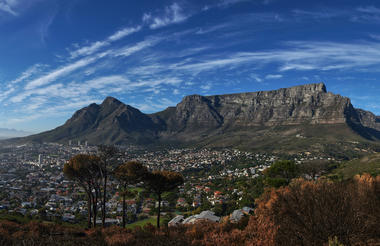
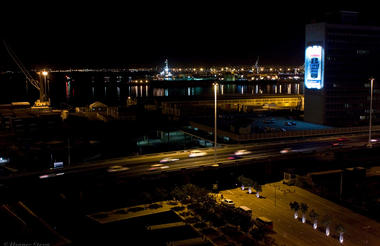
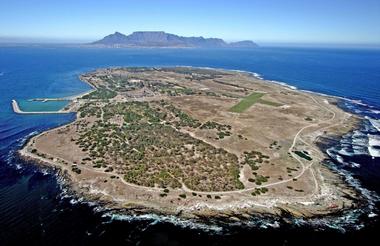
Excursions:
Begin your exploration of Cape Town with a cable car ride to the summit of the legendary Table Mountain - weather permitting. The distinctive-looking mountain is one of Cape Town’s most recognized landmarks. Its tabular shape results from nearly horizontal layers of sandstone exposed by vigorous wind and water erosion.
From the top you'll be able to see to the end of our world, including the city bowl and surrounding suburbs, Robben Island and the layout of this southernmost tip of Africa. At the upper cable station, you will find a restaurant and a curio shop as well as some footpaths for exploration.
Embark on a full day tour of the Cape Peninsula, starting with a drive along the exquisite stretch of coastline known as Millionaire’s Paradise – from Clifton to Camps Bay, to the exclusive beach hamlet of Llandudno towards the charming working harbour of Hout Bay.
Wind along the legendary Chapman’s Peak Drive, hugging the cliffs and relishing the breathtaking ocean views, before arriving at the Cape of Good Hope. Known for stormy weather and rough seas in the winter months (July/August), the rocky headland is situated at the convergence of the warm Mozambique-Agulhas current from the Indian Ocean and the cool Benguela current from Antarctic waters. Grass and low shrub vegetation is characteristic of the promontory, which is part of the Cape of Good Hope Nature Reserve (est. 1939) that encompasses the southern tip of the Cape peninsula. There is a lighthouse on Cape Point about 1.2 miles (2 km) east of the Cape of Good Hope.
Later meander back along the coast towards the city, visiting the historic naval port of Simon’s Town and the Boulders Beach penguin colony, home to a unique and endangered land-based colony of African Penguins.
Take the ferry across the bay to Robben Island – a UNESCO World Heritage Site and a museum, used at various times between the 17th and 20th centuries as a prison, a hospital for socially unacceptable groups and a military base (weather permitting).
Robben Island’s most famous resident was, of course, Nelson Mandela. Its buildings, particularly those of the late 20th century such as the maximum security prison for political prisoners, witnessed the triumph of democracy and freedom over oppression and racism . Highlights include a walking tour of the prison conducted by former inmates, and a visit to Nelson Mandela’s former prison cell, where he spent most of his 27-year prison sentence.
Enjoy a full day tour to the Cape Winelands, a day dedicated to celebrating the glorious grape, the exceptional scenery, the rich history of the region dating back to 1679 and its restored Cape Dutch architecture dating from the 18th and 19th centuries.
Visit the exquisite little town of Franschhoek, pass by the impressive Huguenot Monument, honouring the area’s French settlers, who arrived in the 17th and 18th centuries. And, in a town with a reputation for gourmet fare, where else would you choose to enjoy a scrumptious al fresco lunch.
Then wind your way to the heady heights of the Helshoogte Mountain Pass to meet the charming university town of Stellenbosch on the other side. Stroll through this historic little town - its streets lined with majestic oaks - absorbing the quaintness, and sneaking into the odd store or two.
Experience a cellar tour and tasting at a wine estate, where you'll learn all about the process of winemaking, from grape to goblet, and where you'll be able to purchase your favourite wine to take back home.
This morning you will be transferred to Cape Town airport in time for your flight to Victoria Falls.
On arrival in Victoria Falls you will be met and transferred to your guest lodge, located in the residential suburbs of Victoria Falls, within easy walking distance of town and only 2.5 kms from the iconic Falls (complimentary shuttle). This 20 room eco-friendly lodge is modern and tastefully decorated. Each spacious, air-conditioned room has its own small balcony overlooking the gardens and swimming pool and features a large modern en-suite bathroom, TV, Wi-Fi, universal chargers, mosquito nets and a tea and coffee station. Check in for two nights - breakfast included.
This afternoon, unwind after a day of travelling on a sunset cruise along the banks of the magnificent upper Zambezi River. Enjoy photo-worthy views of hippos, water birds, and other wildlife as you explore the dusk-lit waters and savor a variety of snacks and drinks served on board.

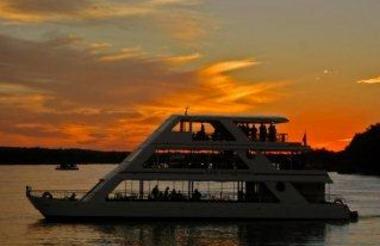
Excursions:
Join a guided walking tour of Victoria Falls, one of the seven Natural Wonders of the World. Explore the numerous spectacular vantage points along the width of the Falls and walk through the permanent, beautifully misty rain forest which flanks the Falls, stopping to marvel at this chasm as the mighty Zambezi river cascades to the depths below the Main Falls, Horseshoe Falls, Rainbow Falls, the Boiling Pot, Cataract Island and Livingstone Island. Stand and watch, feel and listen to the spray and thunderous noise, as millions of liters of water tumble over the Falls into a series of narrow gorges below.
Savour dinner and a drum show at the Boma - a ‘Must Do’ culinary and cultural experience, with exuberant songs, dancers and an extraordinary traditional meal! This unique dining experience, coupled with a feast of entertainment, is a magical night out to remember. Shangaan and Ndebele dancers and singers will inspire you with their pulsating energy, while you tuck into traditional Zimbabwean delicacies, cooked and served in the style of a lavish feast, including irresistible desserts... And for the brave hearts - you may want to taste a lightly grilled Mopani worm! Yes, it’s a night you won’t soon forget.
After breakfast you will be transferred by road to Kasane in Botswana, a typical African town on the Chobe River (approx. 2.5 hours drive). Stay for 2 nights at a typical bush lodge located within walking distance of Kasane town, inclusive of dinner & breakfast.
Each of the 40 spacious and contemporary en-suite rooms are air-conditioned and feature a verandah or balcony with exquisite views over Chobe River.
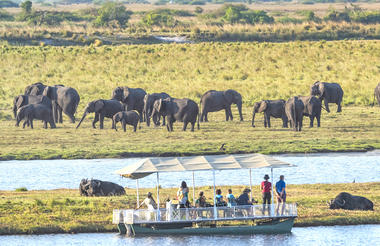

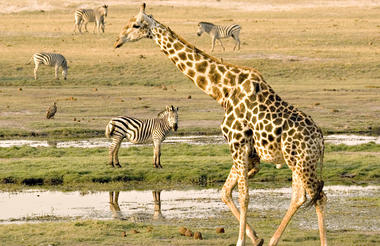
Excursion:
Enjoy an early morning or afternoon game drive in Chobe National Park. Established in 1968, the park covers approximately 11,700 sq kms, encompassing floodplains, swamps and woodland. The Chobe River forms its northern boundary, most famous for its large herds of elephants and Cape Buffalo, which during the dry winter months converge upon the river to drink.
On your game drive you may see large herds of elephants and up to 15 different species of wildlife, including waterbuck, lechwe, puku (endemic to this area of Botswana), giraffe, kudu, roan and sable, impala, warthog, bushbuck, monkeys and baboons, along with the accompanying predators lion, leopard, hyena and jackal, and a myriad of bird species.
Join your mobile tented safari in Kasane and enjoy a morning boat cruise along the Chobe River, spotting wildlife at it comes down to the river to quench their thirst. You can get up close to large herds of animals that are abundant in the Chobe National Park. They tend to make their way to the river and onto the islands in the river to feast on the sweet grass. Puku and lechwe antelopes, buffalo and giraffe and other plains game are often seen on the Chobe floodplains.
Boasting the highest concentration of elephants globally, herds of elephants frequently cross the Chobe River. Hippos and crocodiles like to bask in the sun on the river banks. Furthermore, there are over 460 bird species in the park.
Later your guide will drive you through Chobe National Park to your camp site in Central Chobe. The route takes you through the wonderful Zambezi teak woodlands of the Chobe Forest Reserve, across the sand-ridge and into the stunted mopane scrub of the Goha clay basin.
While there are community areas that we pass through that are settled by local tribes, for the vast majority of the day’s drive we pass through uninhabited country where wildlife moves freely, uninhibited by fences or man. Roan and sable antelope thrive in the teak woodlands where the low density of predators and lack of competition for food by other ungulates makes this prime habitat for these large antelope. Leopard occur in these woodlands in low numbers but they are highly secretive and seldom seen. The Goha region has natural waterholes that hold water well into the dry season and herds of buffalo, Burchell’s zebra, greater kudu and elephant come down to drink.
On arrival at the camp site you will be welcomed by the camp crew, who have already set up camp and are busy cooking up a delicious meal over an open fire. Your camp chef, camp hand and waiter are on hand to look after your every need, from setting up and breaking down camp, to cooking, cleaning up and table service.
After a scrumptious meal followed by a tasty desert, you can enjoy a bit of bush TV (aka the campfire), before retiring to your spacious, walk-in tent - home for the next 3 nights.



The tents are 4 x 3m Sahara style tents with high roof with a 2 x 3m en-suite bathroom and a 2 x 3m covered verandah in front of the tent. The tents are fitted with solid base camp beds made up with mattresses, sheets, duvets and pillows. The en-suite bathroom at the rear of the tent have a chemical toilet and bucket shower. Showers can be ordered as hot, cold or warm and the water is heated in a bucket on the fire. Both hand towels and bath towels are supplied but please bring your own personal toiletries.
Each tent has an oil/paraffin lamp on the verandah and in the bathroom. Within the tent itself, a LED rechargeable camp light is supplied along with a side table in the sleeping area and in the bathroom. Although each tent has lighting and there are lamps strategically around the camp for navigation, we highly recommend that you bring a headlamp which lets you read a book at night in your tent or catch up with your safari journal as you listen to the sounds of the wild outside.
There is a also family safari tent for families travelling with younger children on our private trips, ensuring the children’s safety and their parent’s peace of mind. A family tent is a two-bedroom unit with an adjoining bathroom and lockable exit/entrance with each tent accommodating 2 people in each.
Enjoy morning and afternoon game drives with our fantastic guides!
Wildlife: Undoubtedly it is the interaction between lion and elephant that is the most interesting aspect of Savuti. The area is inhabited by a huge pride of lions with numbers fluctuating from 20-30 members. These remarkable lion have learned over the years how to hunt these massive pachyderms that are supposedly above predation. Launching their attack under darkness and using their numbers, they manage to kill adolescent and even young adult elephant. The marsh is prime cheetah country and in the wet season it is not unusual to have the wild dog hunting here in Central Chobe.



Morning and afternoon game drives.
Birding: The surface water that is pumped into waterholes here provides a major attraction for birdlife. In the dry season thousands of dove and sandgrouse come down to drink in the mornings and are under constant surveillance by Yellow-billed Kite, Tawny Eagle and African Hawk-Eagle. Red-crested Korhaan are common in the Kalahari Apple-leaf (Lonchocarpus nelsii) veld.
The marsh is the summer home for good numbers of Caspian Plover and Montague’s Harrier as well as Chestnut-backed Sparrowlark, Grey-backed Sparrowlark, Northern Black Korhaan, Rufous-naped Lark, African Pipit and Desert Cisticola. Dickenson’s Kestrel, Amur Falcon and Red-necked Falcon are found along the perimeter of the marsh.



Leaving the parched landscape, we continue our journey south to the Khwai Community Area.
Enjoy a fascinating days' drive looking at some of the evidence of the Paleo-Lake Makgadikgadi that dried up some ten thousand years ago. The range of habitat that is covered encompasses most of the ecosystems of northern Botswana. We pass through excellent lion country and some of the best cheetah territory that our safari will cover. Elephant occur throughout the drive, but are more common at the start and end of the drive where permanent surface water can be found.
The most challenging part of the trip is crossing the Magwikwe Sand-ridge that formed the shoreline for this massive inland sea. The winding track through this deep sand makes for interesting travel in the early summer! The old lake bed is now the Mababe Depression, a birder’s paradise. The dense clay floor of the depression results in high protein feed for wildlife and the area teams with game after the rains. During the rainy season (November - April) the depression is impassable due to the “cotton soil” and alternative routes must be used.
Once again you will arrive to camp site that has been set up by your crew, who welcome you with a warm smile and a delectable meal. Spend the following 3 nights at an exclusive campsite in the community area,
Morning, afternoon and night game drives, Mokoro excursions, guided nature walks.
Wildlife: The Khwai region boasts excellent populations of both bull elephant as well as breeding herds. Lion, leopard, serval and African wildcat are common predators of the region with wild dog and cheetah being less common. Buffalo use this area seasonally with large herds moving in during the summer
rains. The swampy areas in the west are home to red lechwe antelope. Other ungulates include tsesebe, blue wildebeest, giraffe, kudu, sable antelope, roan antelope and impala.
In this area you can enjoy morning and afternoon game drives, as well as night drives. Being outside of the national park allows us to take you on game drives into the darkness to see what lurks after the sun goes down.
We spend our time between the dry-land habitats of the leadwood and camel-thorn woodlands and savannahs and the riverside and marshy back-waters of the Khwai River. Time permitting we may visit the lagoons and waterways of Xakanaxa to see the largest heronry in southern Africa.
In this area we also conduct mokoro excursions. Gliding silently along the waterways in these traditional dugout canoes offers a fantastic change of pace and whole new perspective of viewing nature.
Outside the national park we can undertake guided nature walks. Your guide is armed for safety and will teach you about tracking animals and introduce you to the insects and smaller species that make up this diverse ecosystem.
Morning, afternoon and night game drives, Mokoro excursions, guided nature walks.
Birding: Truly one of Botswana birding Mecca’s, the western reaches are prime habitat for the uncommon Rosy-throated Longclaw. The entire length of the river is hunting domain for the Bat-Hawk. Other interesting raptors found here are Cuckoo Hawk (rare), Long-crested Eagle and Black Sparrowhawk. More commonly Tawny Eagle, Steppe Eagle, Lesser-spotted Eagle, Martial Eagle, Bateleur and African Hawk-Eagle are spotted. The waterways host Africa Rail, African Crake, Greater Painted Snipe, Allen’s Gallinule, Lesser Jacana and Lesser Moorhen.
The Khwai River's eastern most extremity is known as the Manuchira Channel. Today’s journey to Moremi National Park follows this water course, with the track weaving from the riverside and floodplains into the mopane veld and the woodlands that make Khwai one of the most scenic areas of the Okavango. We pass the magnificent Dombo Hippo Pools in the morning, stopping to enjoy the scenery and the antics of the resident hippo.
Moremi lies on the eastern extremity of the Okavango Delta. Habitats here range from wide-open floodplains, marshes, lagoons, papyrus fringed channels, vast reed-beds of Miscanthus and Phragmites, woodland and savannah. As a result of the extremely variable habitat the diversity of both wildlife and birdlife is excellent.
As before, your camp site for the next 3 nights has been set up and your crew is ready to welcome you with a freshly prepared meal.
Morning and afternoon game drives.
Wildlife: Every type of mopane habitat is well represented in this area, from the towering cathedral woodlands Xakanaxa to the classic climax mopane woodland and in the drier and harsher habitats, extensive stretches of scrub mopane. The San-ta-Wani region has scattered ephemeral water pans with large floodplains and camel-thorn woodlands.
The western mopane veld is home to mostly breeding herds of elephant whilst the eastern reaches is home to some impressive old bulls. The mature bulls revel in the cool waters and are far more approachable while drinking and bathing than the breeding herds. The river has an unusually high density of hippo as well as some huge crocodile.
Leopard, cheetah, serval and lion are common predators, and the area includes home ranges of 2 different packs of wild dog. General game includes southern giraffe, Burchell’s zebra, tessebe and red lechwe with roan and sable antelope being less common residents.
Morning and afternoon game drives.
Birding: A good day for raptors with African Hawk-Eagle, Gabar Goshawk, Shikra, Little Sparrowhawk, Dark Chanting Goshawk,
Tawny Eagle, Lesser Spotted Eagle and Steppe Eagle all inhabiting the mopane and adjacent woodlands. Other birds common in the area include most of Botswana’s hornbills including Red-billed, Southern Yellow-billed, African Grey, Bradfield’s and the Southern Ground Hornbills. A large number of brood-parasites may also be seen. Diederick Cuckoo, Levaillant’s Cuckoo, Jacobin Cuckoo, Great-spotted Cuckoo, African Cuckoo, Common Cuckoo, Shaft-tailed Whydah, Pin-tailed Whydah, Eastern Paradise Whydah, Greater Honeyguide, and Lesser Honeyguide.
Following breakfast and an early morning game drive, you will be taken to the airstrip for your scenic flight to Maun, in time to connect with your onward flights.
** END OF SAFARI **







